Soccer newsletter: Meet the SoCal team bringing soccer and hope to Darfur refugees
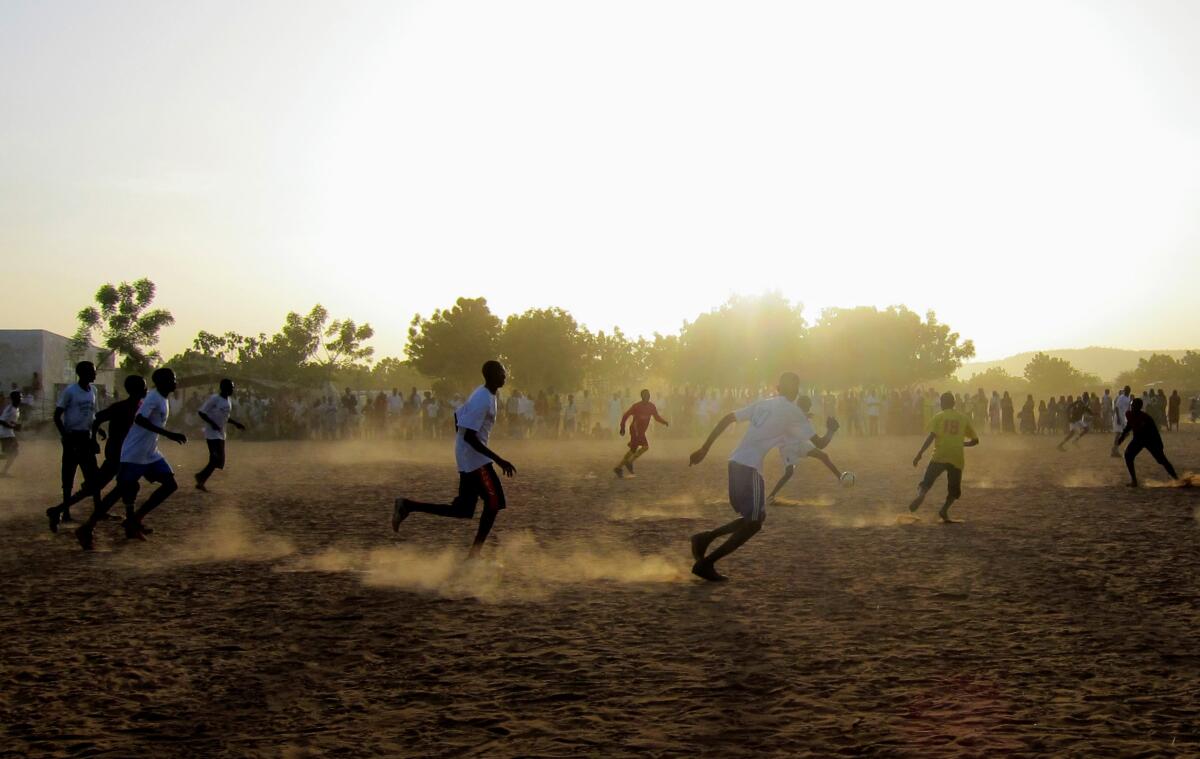
- Share via
Hello and welcome to the L.A. Times soccer newsletter. I’m Kevin Baxter, the Times’ soccer writer, and we start today in Darfur.
Remember Darfur? It’s the region of western Sudan that was the focus of countless humanitarian campaigns and activist fundraising in the 18 years since war broke out there over land and water rights, killing more than 300,000 and displacing nearly 3 million more, according to United Nations estimates.
But the world’s focus has shifted. Civil wars in Syria and Afghanistan, sectarian violence in Africa and the Middle East, religious persecution in Myanmar and political and economic instability in Iraq, Venezuela, Haiti, El Salvador and Honduras have produced a global refugee crisis of horrific proportions.
According to the United Nations Refugee Agency, at the end of 2020 more than 82.4 million people — 1 of every 95 persons on the planet — had been forced to flee their homes. That’s nearly double the number from a decade ago, when the crisis in Darfur was at its peak.
But Gabriel Stauring and Katie-Jay Scott haven’t looked away. In fact, they’re doubling down on their work with the Refugees United Soccer Academy in Chad, home to an estimated 370,000 displaced Darfuri people.
“We just are not going to suffer from burnout or feel hopeless because we see the real difference that it makes in the communities,” said Stauring, founder of iACT, the Hermosa Beach-based nonprofit that administers Refugees United. “The need for this type of work is not going to end.”
Taking soccer to a place where food, clean water and housing are in short supply might seem like a case of misplaced priorities, but it’s exactly the opposite. Hope is even harder to find in many of the 12 camps where Stauring and Scott work, but the Refugees United academies, launched in 2013, have brought that to the more than 22,000 children who have enrolled in the program.
“These camps are forgotten,” Stauring said. “Food rations are at an unimaginably low rate. And education, they barely get any funding. So this opportunity to have this space where they just experience the joy of football in a peaceful environment and where they are seen as whole people, it’s transformational.
“It’s football. But the life benefits in these camps that are so on the edge go well beyond the sport.”
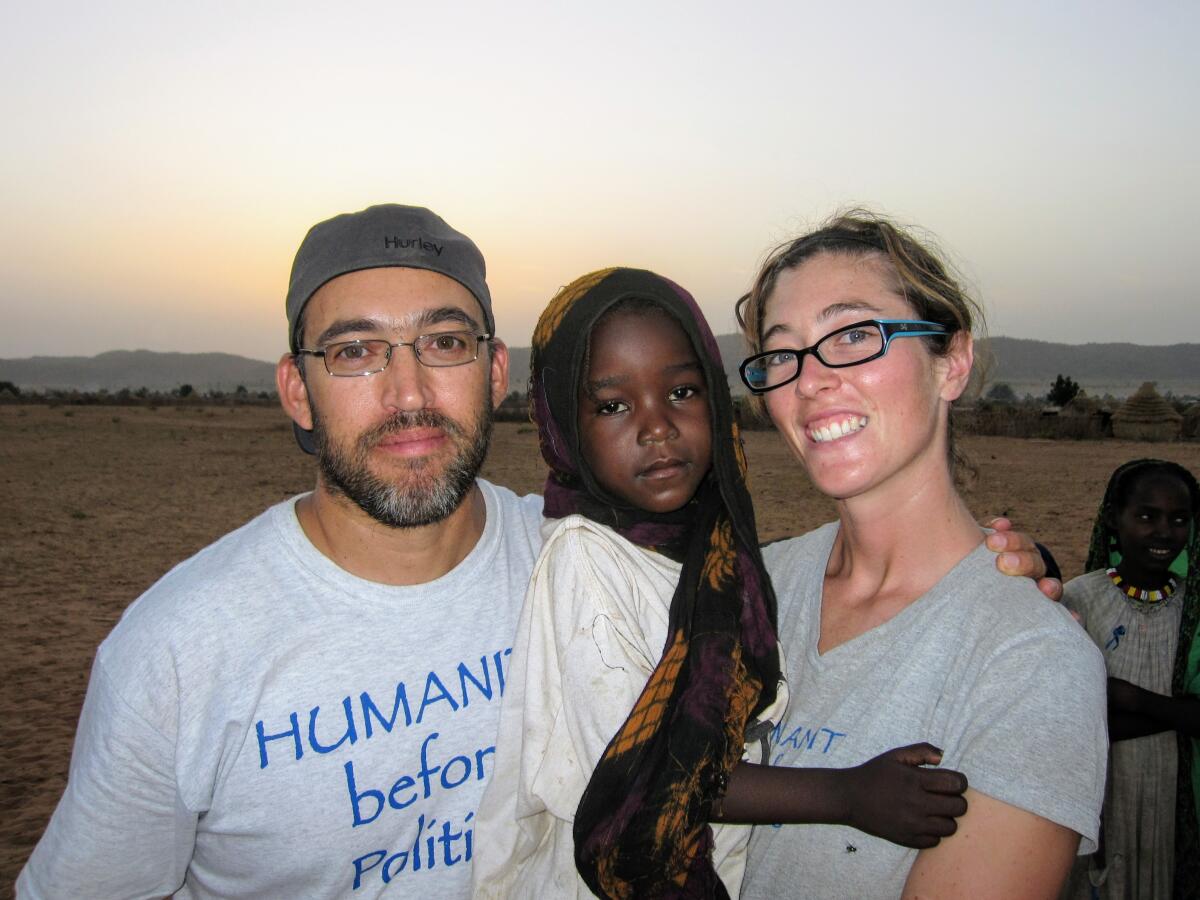
Stauring and Scott first introduced the idea of traveling soccer teams into the camps in 2012, when they overcame enormous obstacles to take Team Darfur, a squad of adult Sudanese men, to a tournament in Iraq. The men struggled on the field, but the concept took hold.
“During that process, we started thinking, ‘OK, how do we support younger generations in the camps? How can we use soccer to provide hope and space for them to experience joy while they wait in this kind of limbo that refugees camps are?’ ” Stauring said.
So a year later, they launched the first academy. Since then, they’ve added eight other camps in six countries, all organized and administered by Stauring, Scott and a Southern California-based staff of 12. But the academies are run on a day-to-day basis by nearly 200 salaried refugee staff members who live in the camps.
Enjoying this newsletter? Consider subscribing to the Los Angeles Times
Your support helps us deliver the news that matters most. Become a subscriber.
Thanks to a grant from the UEFA Foundation for the Children, the program is in the process of expanding to four more camps, increasing a global reach Stauring says is already being felt in 20 countries, from Chad and Tanzania, to Greece, Armenia and the Central African Republic.
The academies primarily are aimed at boys and girls ages 6-13, but the group has also fielded men’s and women’s teams and next March will take a team of 10 girls between the ages of 13 and 17 to the Street Child World Cup in Qatar, where teams representing 21 countries will compete in a 7-on-7 tournament while advocating access to basic needs such as education.
Refugees United has made steady progress toward its goal of equal participation for males and females, and it has achieved stunning victories along the way. For example, many of the women who became coaches had never touched a soccer ball or been entrusted with a leadership role before joining the academy. Now they are mentors. “The curriculum and the framework is all grounded in pillars like social and emotional well-being. It’s grounded in strength-based coaching,” Scott said. “Many times the relationship [the children] have with the coaches is really the only safe relationship that they have. So that’s a big part of the program.”
For the players, the structure of organized sport not only teaches them teamwork and resilience, it gives them confidence, provides a place to heal from the violence and trauma many have experienced and promotes empowerment, peace-building and education, with the academy joining camp schools in pushing attendance and participation in class.
“Most of them were probably born in the refugee camps because these communities have been there for about 17 years. They don’t know another life,” Scott said.
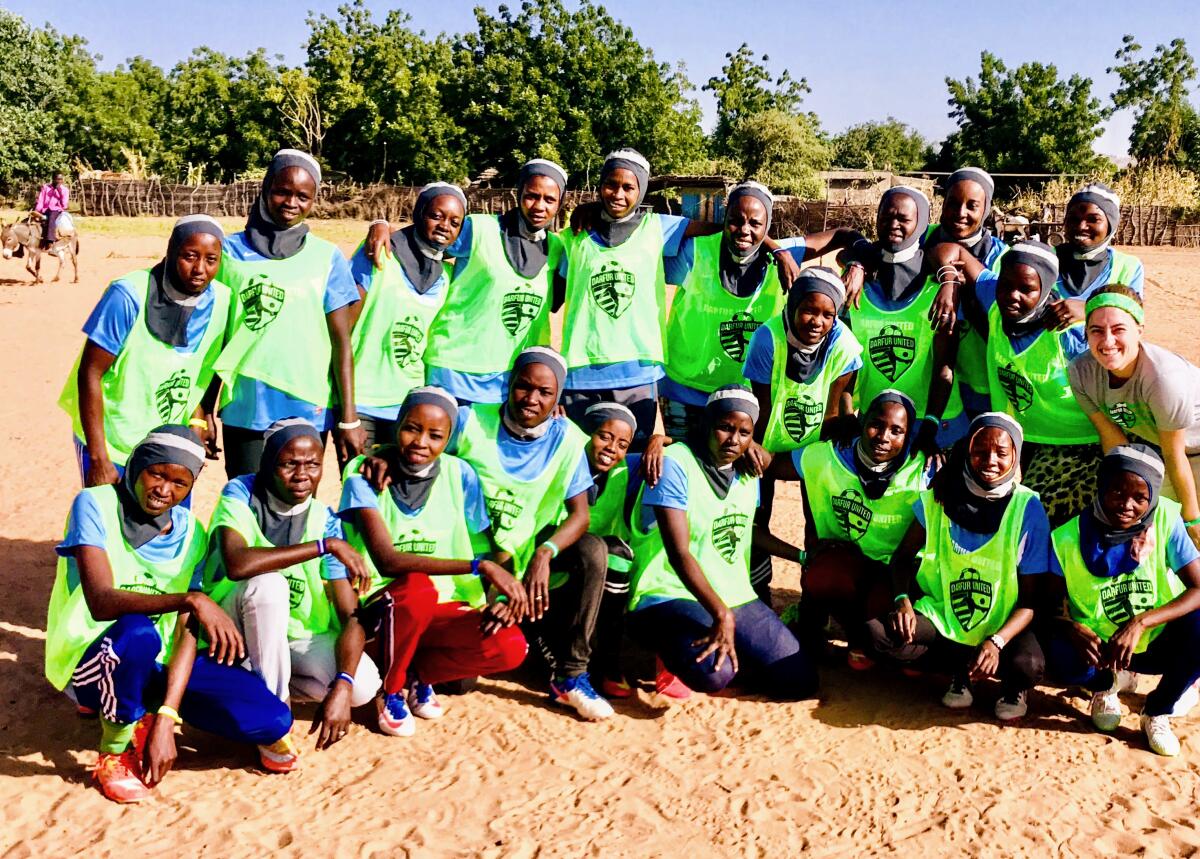
Each academy is designed to accommodate up to 2,000 children who train or play for 60-90 minutes a day, five to six days a week.
“I did not intend to do this. It was just going to be one trip and then I was going to continue with my life,” said Stauring, who first visited Darfur in 2005, when support for the refugees was an international cause célèbre.
“It’s been now 32 trips.
“We choose to go to the difficult places, the forgotten places. Everyone left Darfur and we said we’re not going to leave.”
Stauring, 55, met Scott in Portland, where she was going advocacy work on Darfur. When she asked to join his fledging program he agreed — provided she could raise her own salary. She did and accompanied Stauring on his next trip to Africa in early 2008.
“We actually got caught in a coup attempt on that first trip,” said Scott, 40, now iACT’s executive director.
Two years later they married and eventually settled in Redondo Beach, where their 9-year-old daughter is a budding soccer prodigy. They celebrated their 11th wedding anniversary at last Saturday’s annual iACT fundraiser in El Segundo.
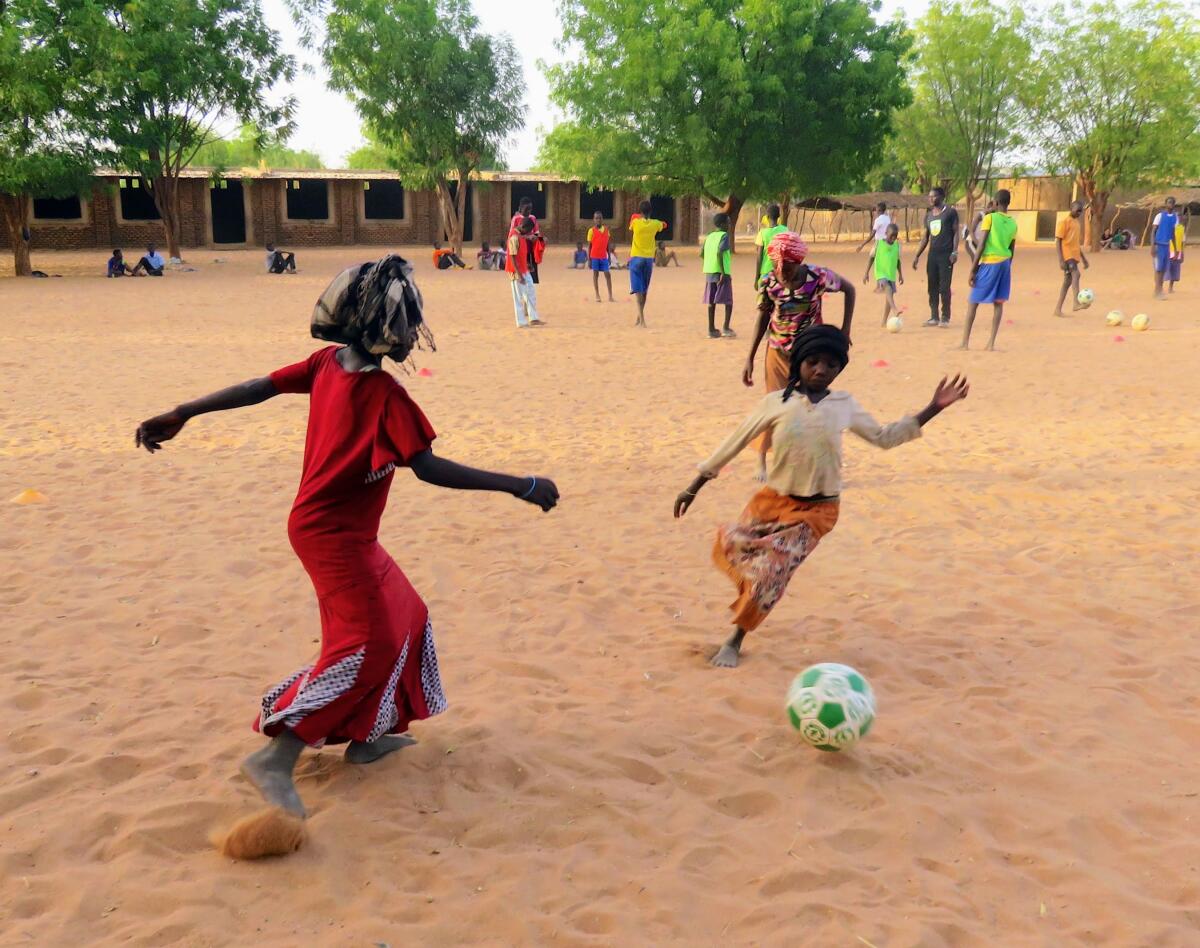
Now they’re about to take a girls team — this one an all-star squad made of refugees from two camps — to Qatar eight months ahead of the FIFA World Cup for what is intended to be a life-affirming, life-changing trip in which soccer won’t be the only thing on the agenda.
“This tournament is just an opportunity for them to really put into practice all the leadership that they’re learned through the academy and represent their people,” Stauring said. “They live in camps that are one of the most remote places on earth, one of the harshest places on earth. The communities have experienced unimaginable violence. Genocidal violence.”
“They are thinking about how to present their case about the challenges for refugee girls living in the camps,” he continued. “They’re going to get exposure. They’re going to be able to speak for themselves. There’s going to be conferences and meetings and they will draft a document at the end that they present to the world.
“So while all of this is about the joy of football, they are also being chosen to be leaders and represent their communities when it comes to education.”
It also will ensure they aren’t forgotten.
To learn more about the program, visit iact.ngo or email [email protected].

A Leagues Cup of their own
There are more questions than answers surrounding last week’s announcement the MLS-Liga MX Leagues Cup will be expanded to a month-long, World Cup-style tournament in 2023.
We know all 47 teams — perhaps 48 by then, depending on the MLS expansion timetable — in the leagues will participate. We know both leagues will pause their regular-season schedules for a month to accommodate the competition, and we know the top three finishers will earn berths in a revamped CONCACAF Champions League in addition to a cash prize.
What we don’t know is when or where the tournament will be played, how roster rules in the leagues will be modified to accommodate such an ambitious project, how the competition will impact the rest of the regional calendar and what it will mean for future partnerships between Mexico and the U.S.
The Athletic took a deep dive into that unknown last week and came back with mostly guesses and estimates. The tournament likely will be staged in late July and early August, meaning it will compete with the Women’s World Cup, which kicks off July 20. That also means the event will come on the heels of the CONCACAF Gold Cup, which will involve dozens of players from both leagues. That tournament is scheduled to end July 16.
MLS Commissioner Don Garber said his league will retain its 34-game, regular-season schedule but will pause that for a month to accommodate the expanded Leagues Cup, which will add at least two and as many as seven games for each team. The return of the U.S. Open and Canadian cups will add to the fixture congestion, as will international breaks and the CONCACAF Champions League. All that likely means the season will start as early as February and finish in December. For teams that advance deep into the playoffs, the offseason will be just weeks long.
“I think there is enough time to play those competitions,” Vancouver Whitecaps FC sporting director Axel Schuster told MLS.com. “We have two years to find a way to sort that out. A few years ago everyone said, ‘It is impossible to play a World Cup in December because all the European calendars will not work and there was no chance that you can fit in a World Cup at the end of the year.’ And next year we will see that easily fits in and that all calendars can work around that.
“So [the] calendar is always something we discuss, and nobody ever will be happy with the calendar. But I’m pretty sure it will work.”
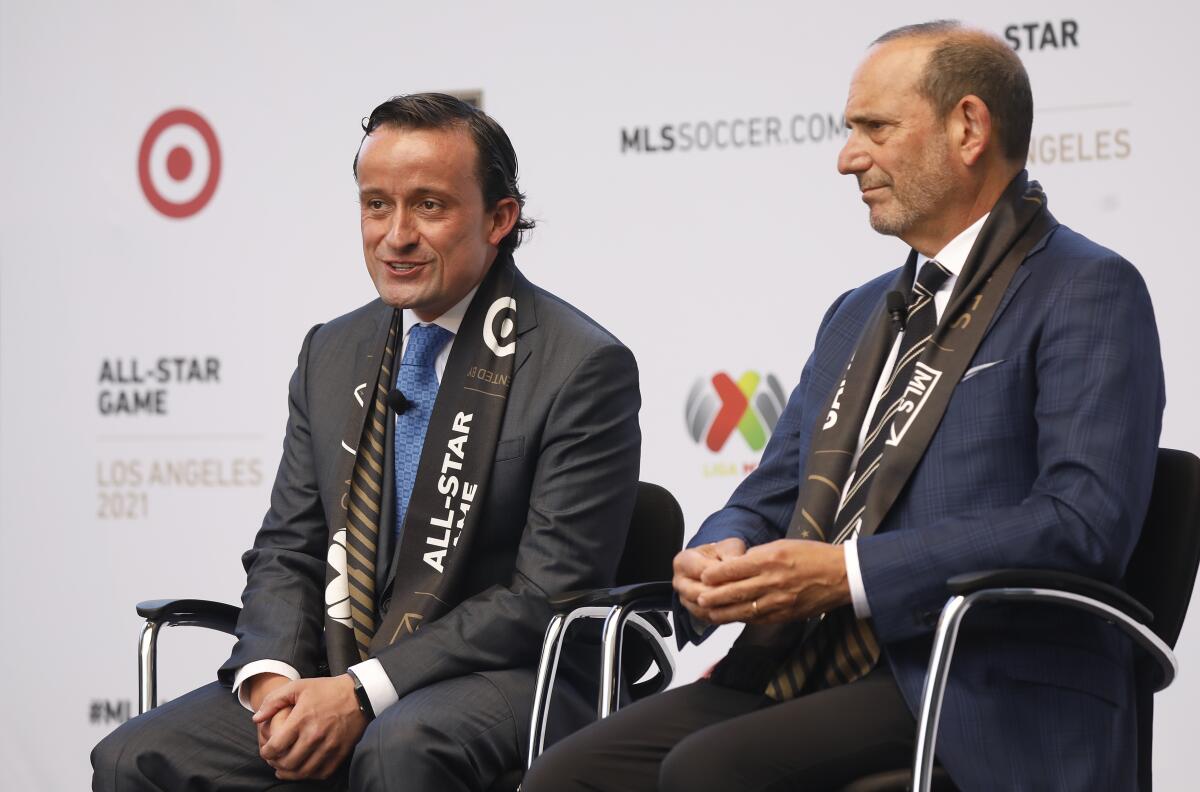
Making it work almost certainly will require additional roster spots, modifications to the rules regarding the promotion of players from second teams and academy programs and an increase in spending to accommodate additional players and, in MLS’ case, recruit the talent necessary to compete with Liga MX.
An MLS team hasn’t won the CONCACAF Champions League — the region’s most important club competition — since 2000. Liga MX teams have won 17 of the 19 tournaments since then, with an MLS club reaching the final just four times during that span. That won’t change this year, with Mexican clubs Monterrey and América facing off in next month’s final.
The new tournament, according to the Athletic, will begin with each team playing at least two group-stage matches with the top two in each of the 16 three-team groups advancing to a 32-team knockout round. That means as many as 16 teams would be eliminated in the first week, leaving them idle for the rest of the month-long event.
There are few answers as to how the tournament will unfold, but there’s no mystery as to why. MLS desperately needs to increase its supporter base and TV ratings, and drawing more Mexican and Mexican American fans from both sides of the border is something that has long infatuated Garber — especially now, with the league in negotiations for a new broadcast deal.
Liga MX, meanwhile, was inspired by the Mexican national team’s successful and lucrative example of playing more games in front of wealthier fans and sponsors in the U.S. That’s why the expanded Leagues Cup will be played entirely in the U.S. and Canada, drawing exposure and income opportunities that could prove especially important for lesser-known Liga MX teams.
Finally, there’s the timing. With the 2026 World Cup to be hosted jointly by the U.S., Mexico and Canada, increased cooperation between the countries just as the world spotlight begins to shine on the region significantly could boost the soccer profile of all three nations.
“We need programming, we need partnerships and activities so we don’t just wait for it to come,” Garber said. “This tournament will be rocket fuel. The World Cup is a transformational opportunity for our league.”
Much remains to be done to make the tournament a reality — not the least of which is finding a way to close the competitive gap between North America’s top biggest leagues. If MLS can’t find an answer to that question, the others become moot.
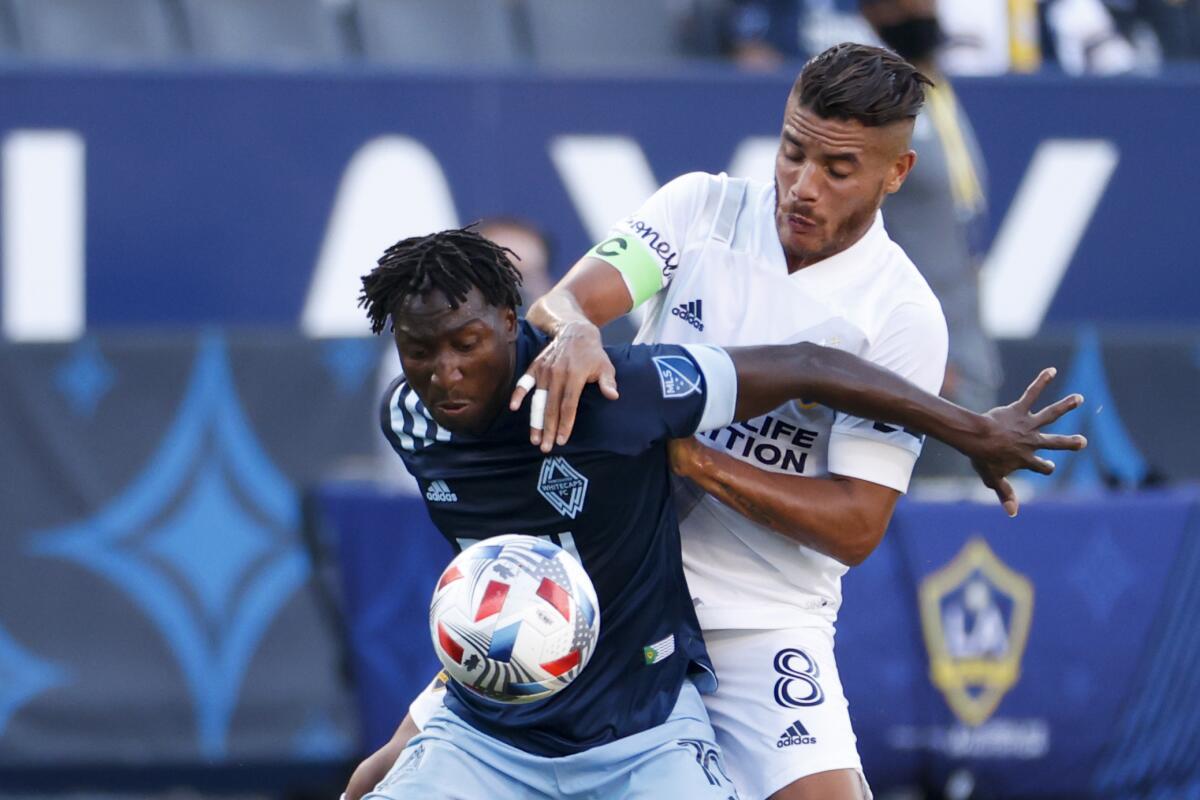
Playoffs in danger of disappearing for Galaxy, LAFC
Six months into a seven-month season probably is not the ideal time for teams to still be seeking their identities, but that’s where the Galaxy and LAFC apparently find themselves with eight games left in the regular season and playoff berths slipping from their respective grasps.
The Galaxy’s season-long winless streak reached seven in Sunday’s uninspired, 2-0 loss to cellar-dwelling Austin, the third defeat to a last-place team in less than nine weeks. Another loss Wednesday at Real Salt Lake could drop the team (11-10-5) out of a playoff position entirely.
LAFC (9-11-6), which has won just three of its last 13 games, is in worse shape. Consecutive road losses to Portland and San Jose last week left it three points shy of a playoff berth with four of its final eight games on the road, where it is 3-9-1. Two years ago LAFC posted the best regular-season record in MLS history, but even with a win over Portland on Wednesday it will enter October with a losing record for the second consecutive year.
Both teams realize they’re running out of time.
“We know that every game right now is like a final,” Galaxy midfielder Jonathan dos Santos said. “Every small detail can change the game. I think we have to change that mentality.
“I’m worried of course, because we have eight more games. We know that all the teams are very close to us. I think it’s just one win and everything will change.” The Galaxy have been hurt by injuries and international absences, with just 11 of the 29 players used this season playing as many as half of the team’s available minutes. That has forced coach Greg Vanney to experiment with multiple lineups and pairings, and chemistry and familiarity have suffered as a result.
Vanney said he saw progress in the Austin game, which the Galaxy dominated in virtually every statistical category including possession, shots and shots on target.
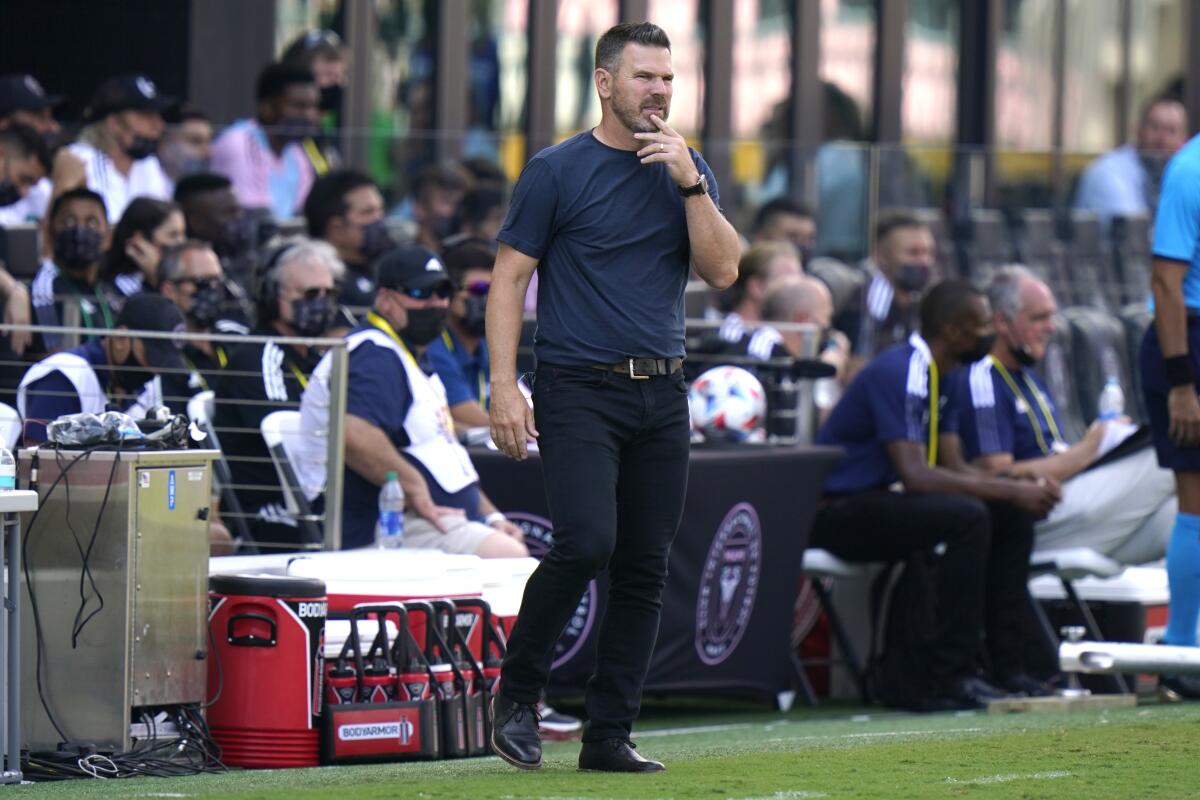
“At some point the timing is going to get right. The finish is going to get right,” he said. “We just have to keep working. And when it comes to finishing, some of this is just timing. It’s composure in front of the goal, it’s taking a moment when we get it.
“Everybody feels urgency and everybody’s disappointed. There’s a sense in the locker room that the guys put out a good shift and it’s about execution.”
After winning seven of their first 10 matches the Galaxy have won just four times since June. And after scoring multiple goals six times in their first 10 outings, the Galaxy have been shut out in consecutive games for the first time in more than a year and have scored multiple goals in a game just once since July.
When the Galaxy score first, they’re 10-2-2. In the 12 games in which they conceded the first goal they’re 1-8-3 and have been outscored 27-9.
“It would be helpful for this group to get a goal, to get ahead and not feel like we have to chase a game, to have the emotion of where we can protect the goal for once instead of getting behind,” Vanney said. “So are there alarm bells? For sure. Everybody feels some urgency to obviously shift the momentum to get that result that we need to keep going.
“But … we’re in a position right now where we control our own destiny.”
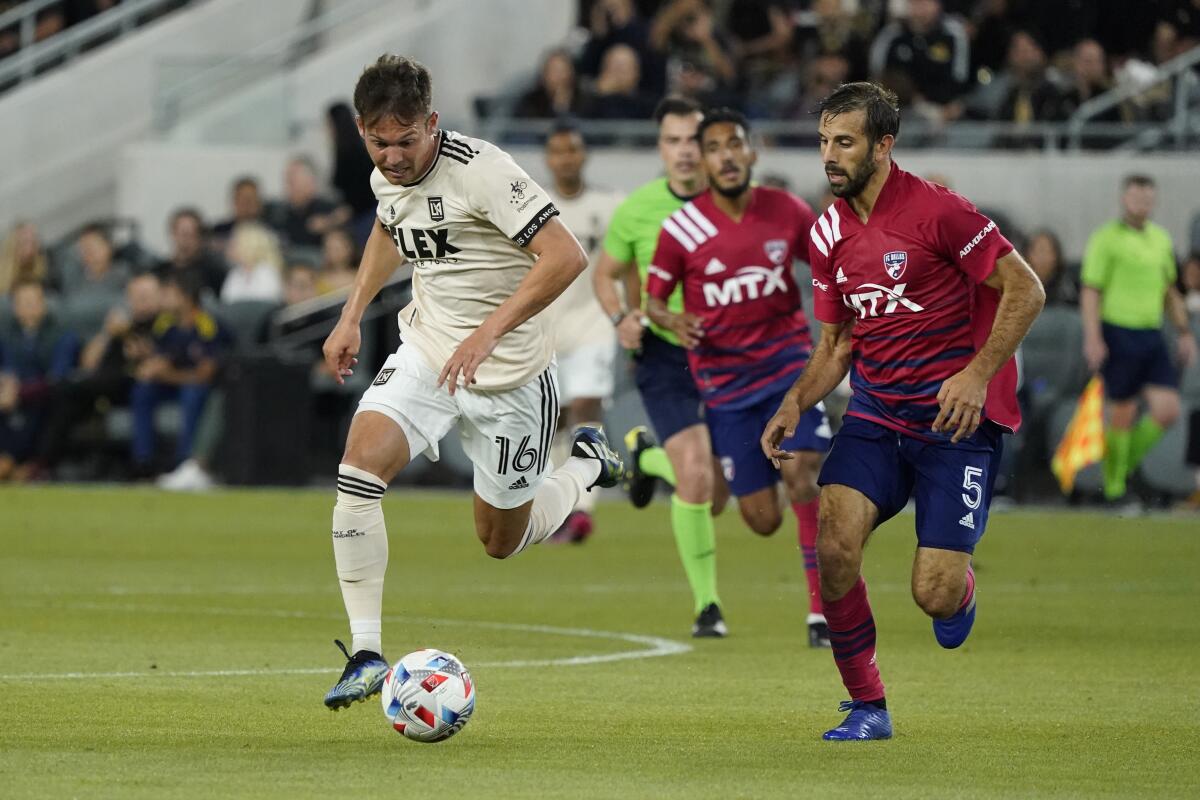
So does LAFC.
“Every single game right now is important,” forward Danny Musovski said.
“Eight games left. That’s plenty of games. If we can get in a good way and take advantage of these eight games and take points, then that puts us in a good position to make playoffs. These games lately have been hurting us because we’re losing to teams that are right next to us in the table.”
Beginning with Wednesday’s home game with Portland, LAFC plays just one of its final eight matches against a team with fewer points in the standings. That means every game gives LAFC not only a chance to gain ground, but also a chance to prevent its playoff rivals from moving further ahead.
But it will need to get better to make the most of the opportunity.
The team LAFC is fielding now is not the same one with which it started the season. Or even the one with which it started the summer. Wednesday’s game will be the sixth consecutive time the team has played without Carlos Vela (injury) and Diego Rossi (transfer), the league’s last two Golden Boot winners. As a result, the offense now runs through Colombian newcomer Cristian Arango, whose five-game goal-scoring streak came to an end in last Saturday’s 2-0 loss in San Jose.
“When you get to this time of the year and you’re in big games and you come up empty like that, I’ll start with myself. Obviously in all ways tonight wasn’t good enough,” said coach Bob Bradley, whose team has led for just 16 minutes in the last three games. “I’m going to do everything I can to get these guys ready to go after these last eight games.”
LAFC gave up goals in the first three minutes of both halves in San Jose, and with forward Brian Rodríguez unavailable with a minor hamstring injury Bradley had just five outfield players on his bench.
“It’s not about one category. It’s about, in a game like that, being better in all ways,” Bradley said. “There’s not one part of the game tonight where I’m satisfied with how we played.”
And finally there’s this …
FC Cincinnati sacked manager Dutch Japp Stam on Monday and replaced him with Jamaican Tyrone Marshall on an interim basis. Real Salt Lake, Vancouver and FC Dallas also are working under interim managers. Cincinnati (4-13-8) has used five coaches, including interim appointments, in its two-plus seasons that have resulted in just 14 wins. Ten MLS teams have made at least one managerial change since the end of last season.
Podcast
Don’t miss my weekly podcast on the Corner of the Galaxy site as co-host Josh Guesman and I discuss the Galaxy each Monday. You can listen to the most recent podcast here.
Quotebook
“Economic benefits can be re-invested creating a virtuous cycle assisting the development of players, clubs, and marketing opportunities for football and sports in general. This day represents a before and after for the whole North America, Central America and Caribbean regions as they will greatly benefit from this agreement.”
Liga MX president Mikel Arriola on the impact of the expanded Leagues Cup
Until next time...
Stay tuned for future newsletters. Subscribe here, and I’ll come right to your inbox. Something else you’d like to see? Email me. Or follow me on Twitter: @kbaxter11.
Go beyond the scoreboard
Get the latest on L.A.'s teams in the daily Sports Report newsletter.
You may occasionally receive promotional content from the Los Angeles Times.




